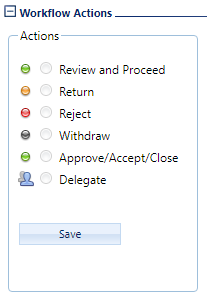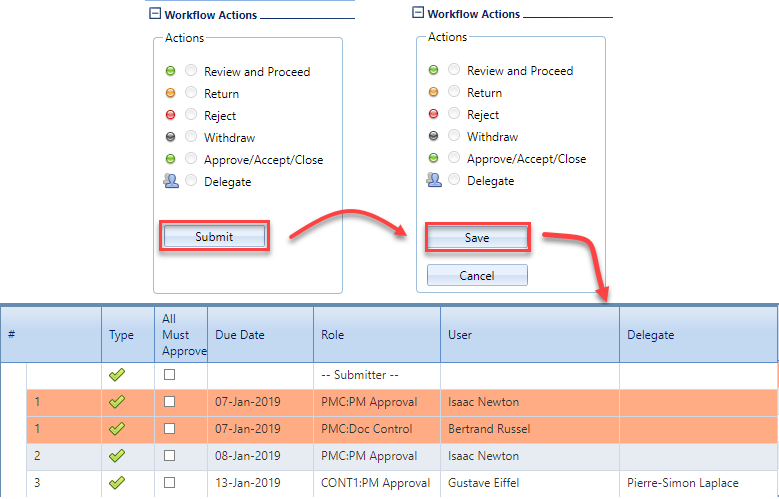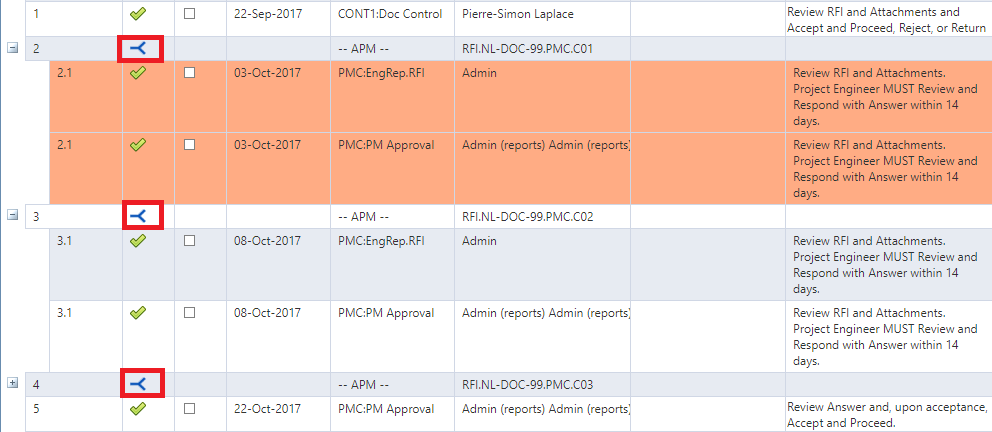The workflow of each managed document is customizable, a document type (e.g. Transmittal) can have different workflows depending on the project, it can also have various workflows in the same project, in this case the workflow to follow will be determined by some input parameter like Creating Company, To Company, Discipline, WBS, Category etc. The workflow steps of each managed document are defined during the project setup.
Workflow creation
The document workflow is automatically generated when the managed document is submitted and saved.
Once you have your document ready to be in a workflow, go to the workflow tab and click in Submit and the Save. This will create the workflow and will go to the first person on it.
Once a document is submitted, a workflow gets assigned to it. This workflow will depend of different parameters as previously explained. If the input parameters do not lead to a right workflow the Default (aka System Workflow) is selected.
The cause could be:
- The project was not setup correctly.
- Wrong parameters were chosen.
- The requested communication line is not allowed.
Sometimes there are some constraints when creating a document type (e.g. PMC send an Instruction document to the Terminal Construction team), data validation is still not implemented in the system, the result of creating an invalid document will be a system workflow:
The document with a system workflow will still appear in the Document log. It would be needed to make a 'Withdraw' action to remove this document from the document log:
Workflow Roles
After a workflow is created, workflow Roles assigned to each step will be shown.
It starts with the Submitter in step 0. Thereafter, it is setup by default (or project customized workflow) with customizable roles.
A single person must be assigned to each role, but people can take ownership over multiple roles. A workflow is set up in a manner to assign certain responsibility to the respective step. So for instance, when seeing a Doc Controller in a work-flow step, its purpose is likely to make sure the content/attachments are in order, perhaps check the header information, custom document number, etc.
The Project manager step is mostly a final approve step, or a step before sharing content with another company. Its action could (or is in most cases) paired with a dated signature on the cover sheet.
Extra roles can be created, users assigned to these roles, and put in at these steps as well. This would share the responsibility. However, for the Project Manager steps, it will always be the ownership of the Project Manager. So his dated signature will be used on the managed documents.
Document responsibilities
Part of responsibilities is explained in 'WorkFlow Roles:'. When a document is entered into a workflow (Submitted by the submitter), the document can only be amended by the currently assigned person in the workflow. For each step, the rights on the document can be managed. So e.g. after Submit, header information cannot be changed anymore; at another step, the body cannot be changed anymore, or perhaps attachments cannot be amended.
Workflow Actions

-
Review and Proceed: confirm that you checked the document and it is okay to continue to the next step of the workflow.
-
Return: After being reviewed, you could decided to return the project to the previous phase of the workflow. The step the document returns to is dependent on how the workflow is set-up it could go to the previous step or perhaps it could skip a few steps to have a multiple roles look at the document again. Not for each step the Return option is allowed. Like a Correspondence or Transmittal is a mere delivery, so one way only.
-
Reject: This immediately closes the workflow. It is not always allowed to do so. One might want to reject for instance, when you have not sent the correspondence to the Contractor yet, and you notice it won't be needed anymore, or the Header information is wrong and you want to create a new one.
-
Withdraw: Only the Submitter can withdraw a document. Themself can do so, if believing the document isn't needed any more. Be aware that this is not to make adjustments. After Withdrawal, the workflow is ended. Withdrawal cannot be done in every workflow step. Like for a correspondence (letter), it is not allowed to withdraw a document after it is sent to the receiving company.
-
Approve/Accept/Close: this option will be the final step of a workflow, selecting it you will close the workflow. This likely can only be selected in the final step of the work flow. It also just as the proceed work-flow means you agree with the content. It only puts an end to the work-flow. Like for an Correspondence, Transmittal, it only confirms you received the document and you close the work-flow.
-
Delegate: Delegation can be used to keep the document still in the same step, but you want someone else be able to take current work-flow action. So, although the ownership of the step stays with the current work-flow role, the responsibility can be shared. This is the general meaning of delegation. However, there are exceptions. Like for the Inspection Request Form. Here, at certain step, the Delegate is considered to be the inspector, whose sign-off is dated on the cover sheet as well.
This manner of delegation is by document. So when a user selects the delegate option. However Admin can help with temporary (or without end date) delegate all responsibilities (for certain Role) from one person to another.
Branching
It is also possible to create multiple branches within a single workflow. The workflow rules help to determine which branch to follow.
In the image below you can see 4 branches availables in a submittal item workflow that rely on the WBS selected for this document.
Branching in a workflow is used to guide the workflow to specific roles. For instance, a request for information considers the need of a specific engineer, then the work-flow can be branched to be guided to this or another engineer. The branching rules can be setup specifically for each project. As this example, the branching would depent on Discipline, so Electrical would go to an Electrical Engineer, while plumbing/ or safety would follow a completely different path.
The branching works as follows; at each branch it is evaluated if the branch needs to be entered, so it is possible to go into multiple branches or none at all.




